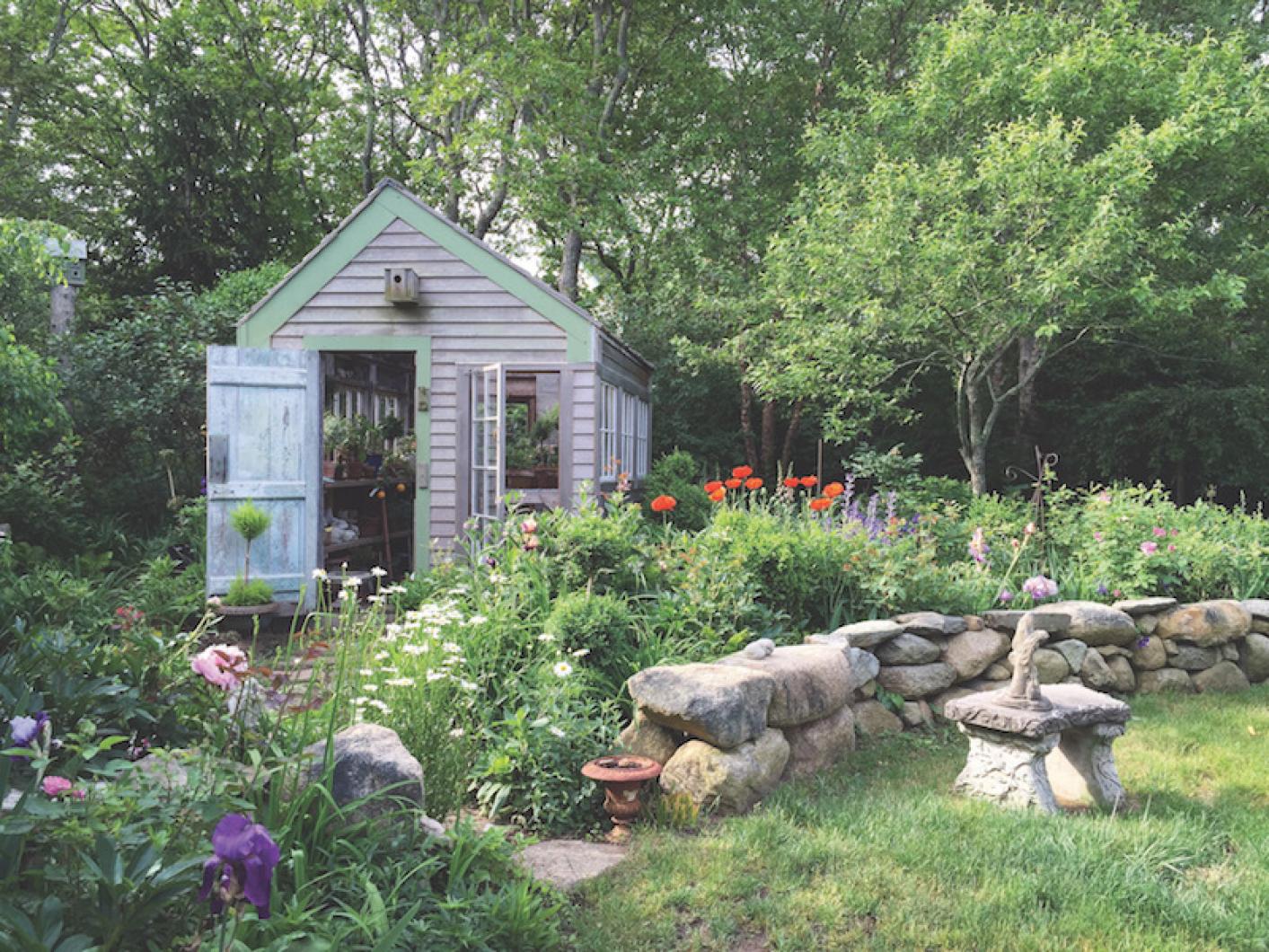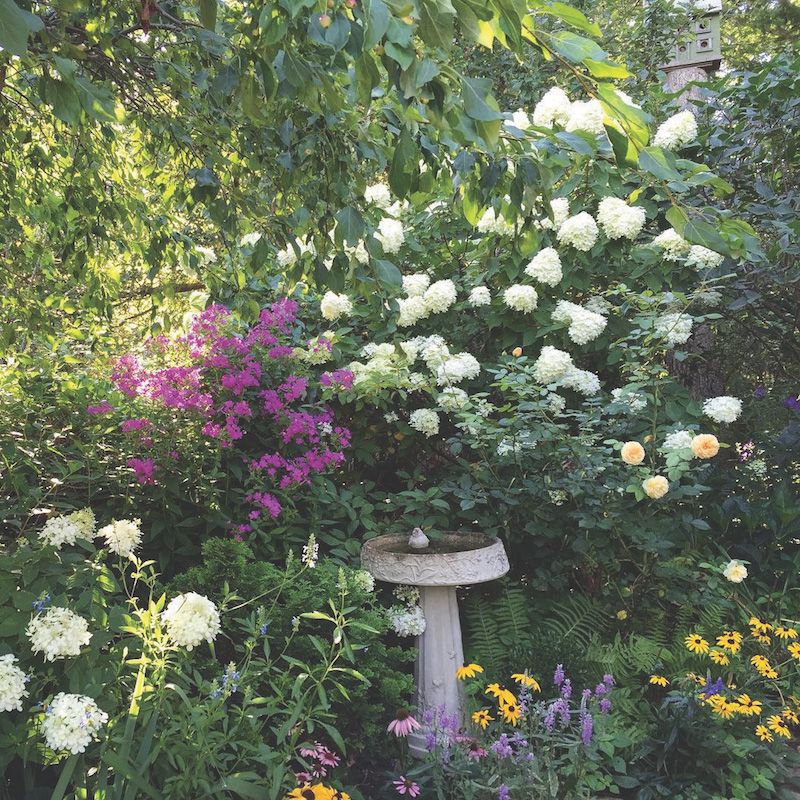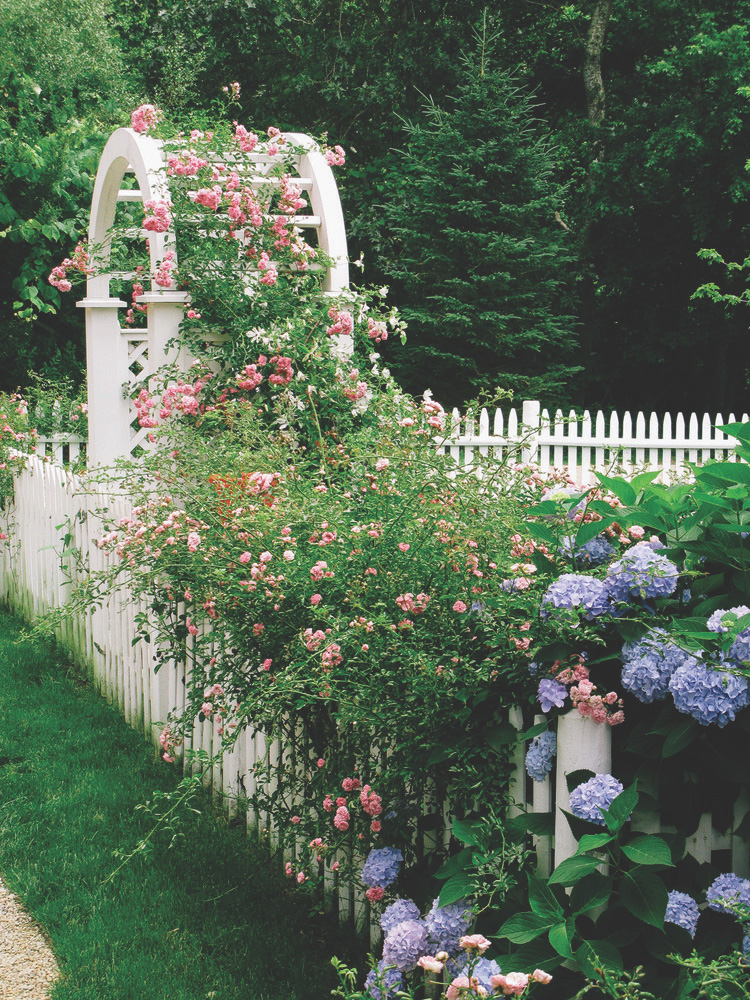“Cottage gardens are very personal,” West Tisbury garden designer Mary Wirtz tells me. “There is no wrong way to do them.”
Hallelujah.
Those of you who worship straight lines and sharp angles, you can all shuffle to the other side of the room for now. (Though feel free to eavesdrop and come shuffling back.)
The rest of you, we’re going to have an inspiring, creative session about the fun stuff that goes into a cottage garden. Sure, we’re going to impose a few guidelines (because we all crave boundaries), but we’re mostly going to focus on beauty and whimsy.
We’ve consulted with Wirtz, who has been designing and maintaining gardens all over the Island for 24 years through her business Wild Violets, to help us distill the useful bits and to offer inspiration, too.
Cottage Garden 101
First, we should all get on the same page about what a cottage garden is. You know, in the very broadest sense.
A cottage garden is small; cozy if you will. It’s loosely defined by a low fence, a stone wall, or a shrub border. It generally hugs a structure. It may settle itself right outside the kitchen door, or it may fall in behind the picket fence in your front yard. Or it’s a little side garden next to a shed. But it’s not a fancy border stretching as far as the eye can see. Fancy? No. Fanciful, yes.
Often a path — a gravel path, a stone path, a brick path — meanders through a cottage garden. Interesting objects pop out where you least expect them; objects like bird houses, bird baths, bird whirligigs, actual birds. When ambling through, you might spy a cool structure, like an arbor or an espalier, a trellis or a teepee. Obelisks and topiaries — they’re all welcome.
And a cottage garden is a riotous, colorful, jambalaya-jumble of flowering plants. In fact, the first thing you’ll want to think about, when considering a cottage garden, is the flowers.
Did we mention that it’s all about the flowers?
Flower Power
There’s nothing quite like walking outside on a warm breezy day and pausing to sniff the fragrance of a summer rose, to watch a bee go nectar-diving in a foxglove, to take in the arresting surprise of a bright orange poppy that’s burst on the scene, or to snip a few daisy blossoms to drop in a tin can next to your computer. A flower garden is pure joy, we’re sure of that. So how do we get started?
“A cottage garden is an evolution. You don’t have to do it all at once — in fact you really can’t. I actually added my greenhouse after the garden started to take shape, and I added the stone wall last!” Wirtz told us.
In the space where her cottage garden (pictured at left) is now, Wirtz first turned the soil over for a few vegetable beds. But they slowly disappeared under a flurry of flowers, which Wirtz began collecting enthusiastically. You can do the same thing, starting with just a few plants.
We asked Wirtz whether we should plant perennials (flowering plants that live longer than two years) or annuals (plants that may bloom profusely through the summer but that only live one year).
For a cottage garden, Wirtz favors mostly perennials, with just a few annuals like white cosmos and deep blue salvias sprinkled in — and maybe a nasturtium or two. “I let the [perennial] flowers do what they are meant to do throughout the season,” instead of trading annuals in and out. “At the end of the season, I don’t mind if a perennial is mostly stems and seed heads with a few re-blooms. I tuck pumpkins and maybe a few cabbages around and enjoy the look.”
Many perennials will only bloom for a few weeks during one period in the summer, but some will re-bloom if cut back, and in all cases, the blossoms — and often the foliage — are worth it. The biggest advantage to perennials, of course, is that they do not need to be replanted every year.
Wirtz’s favorite flowers are roses. She especially likes the fragrant and gorgeous David Austin English roses, many of which are repeat-bloomers. She now has about 25 different varieties. Climbing roses, which can be trained over fences or up trellises, are cottage garden icons, too. (Sadly, in some parts of the Island, and depending on where the garden is located, deer may feast on roses if they’re unprotected.)
But in addition to roses, Wirtz recommends choosing a variety of plants based on when they tend to bloom, so that you can have color from late spring through fall. (For a list of Wirtz’s favorite cottage garden plants, organized by bloom-time, see the next page.)
In addition to seasonality, consider choosing plants of varying heights and those that have interesting foliage when the blooms are over. Wirtz loves the foliage of tree peonies.
You’ll also want to put some of your plants in pots or other containers. Herbs that might spread, like mint, are good candidates. And you’ll want to keep decorative plants like topiaries in pots so that they can be brought into a greenhouse or sunroom for the winter. Sprinkling the garden with pots also adds some stockier shapes to contrast with taller perennial flowers.
Adding Character
Now this is where things get interesting. You certainly don’t want your cottage garden to look like it’s the depository for rejects from the Dumptique, but you do want personality. Before Wirtz had a stone wall, she repurposed odd lengths of picket fence that she’d found and nudged them around the garden. She is obsessed with topiaries of all shapes, and with urns. One urn, minus its base, sits atop a tree stump as a planter. Three birdhouses are in the garden—as are a couple of stone bunnies along the moss- and thyme-covered stone path.
On the Vineyard, there is no shortage of beautifully time-worn objects to add to a cottage garden: galvanized metal feed buckets, glass bottles, jugs, old window frames, locust branches, wagon or bicycle wheels, wooden carts, old rakes and garden tools, kitchen colanders, saucers, teacups, cast iron or wooden gates. Add an old cast iron or metal café chair or improvise a seat with rocks.
Shopping for new items is fun, too. The little garden shop at Heather Gardens has a lovely and interesting selection of garden ornaments, including watering cans, pots, and bird houses. Donoroma’s “Antique” greenhouse is a garden decorator’s dream. And Eden, SBS, Mahoney’s, and Middletown Nursery are good stops, too, for small items or larger ones like trellises.
A bird bath, a sundial, a totem, or a stone statue can make a wonderful focal point for a cottage garden, but since these are big-ticket items, you can add them in later years if you like.
Sheer whimsy? Glass flowers, whirligigs, scarecrows, glazed balls, bottle trees, tin roosters or dragonflies, fairies of any sort. Need inspiration? Hint: Pinterest. You don’t ever have to stop adding to your cottage garden, or taking away from it. Its character will get richer and livelier as years go by. A few things will die, others will seed like crazy and pop up everywhere. Your cat will find his favorite spot to stretch out, maybe on a carpet of thyme. Or perhaps a rabbit will make her nest under a hydrangea. A climbing rose will find its way over the fence; hummingbirds and bees will return every year to visit the foxgloves and the hollyhocks; maybe you’ll even build a little greenhouse to overwinter your topiaries or to start seedlings in the spring. Who knows? And that’s the best part.
Great Flowers For the Cottage Garden
Late Spring Bloomers
alliums
brunnera
columbine
iris
lady’s mantle
primrose
peony
poppy
Summer Bloomers
catmint (nepeta)
daylily
delphinium
foxglove
hollyhock
lavender
lupine
roses
Shasta daisy
verbascum
veronica (groundcover)
Summer/Early Fall Bloomers
black eyed susan (rudbeckia)
catmint (nepeta)
coneflower (echinacea),
left
hydrangea
phlox (garden)
dill




 1 comment
1 comment










Comments (1)
Comments